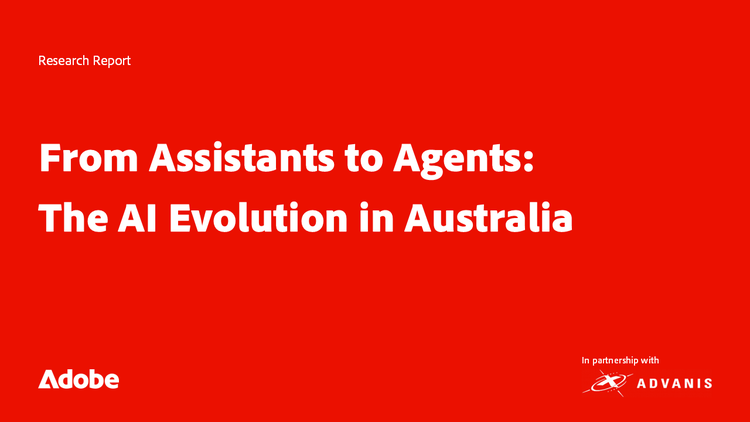
SYDNEY, Australia – July 2, 2025 – Australians are rapidly changing how they use AI, with the number of people using general purpose AI assistants and emerging agentic AI solutions leaping in only a matter of months.
New research from Adobe found the use of agentic AI – systems that can interpret intent, make decisions and take autonomous action – jumped 50% in just three months. Almost one in five Australians (18%) have now used agentic AI, with a further 42% stating they expect to use it in their daily lives within the next year.

The findings come from Adobe’s dual-wave survey of more than 1,000 Australians, testing AI usage and behaviours between March and June 2025. The Adobe report, From Assistants to Agents: The AI Evolution in Australia, found that as more consumers turn to AI, it’s leading to structural shifts in how they shop, create and work.
One in three Australians are now regular users of AI assistants, up 7% since March. That’s likely to keep growing, with two in three stating they are wanting to use AI more as AI evolves with new capabilities and services.
While people are using AI assistants for routine tasks like summarising materials, the fastest emerging areas of use are replacing traditional search and seeking guidance on where to shop and what to buy.
Usage is climbing quickly across all generations, but regular AI use has grown the most among Millennials, jumping from 29% in March to 41% in June.

Katrina Troughton, Vice President and Managing Director, Australia and New Zealand, Adobe said, “We’ve seen a dramatic shift in just three months. Not only are more Australians adopting AI, but they are embracing new capabilities.”
“The surge in agentic AI adoption indicates that it’s no longer just about getting smart answers; people want AI that can act and make decisions. It signals yet another shift in behaviour and expectations among consumers that are translating into new AI-assisted pathways to discover and engage with brands.”
For example, Adobe Brand Concierge will enable businesses to create and manage AI agents that guide consumers from exploration to confident purchase decisions. Using immersive and conversational interfaces that are grounded in user context and preferences, brands can deliver concierge-style experiences that create meaningful, one-to-one interactions.
More consumers use AI for shopping, travel, personal finance and creative tasks
Consumers are expanding the ways they utilise AI assistants across various sectors and use cases. The use of AI assistants is steadily growing for online shopping (30%), travel (29%) and banking (23%), and satisfaction is high (87%+) among these users.
Creative and multimedia tasks are another rapidly growing area of adoption. More than half (57%) have already used AI for creative projects. Many plan to continue using AI over the next six months for uses like writing (52%), photography and photo editing (45%) and graphic design (45%).
Adobe is helping people accelerate their work and amplify creativity by building agentic AI capabilities into the software they already use. For example, AI Assistant in Adobe Acrobat will soon enable people to create custom agents that can be assigned specific roles — like research assistants or academic tutors — ready to help analyse documents, answer questions and use reasoning to suggest further areas to explore. Adobe also introduced its first creative agent in Adobe Photoshop with the all-new Actions panel (beta), which analyses your image and recommends smart, context-aware edits.
Rising interest in agentic AI signals next wave of AI-driven experiences
Millennials are setting the pace for agentic AI adoption, with 23% already using agentic AI, up from only 13% in March 2025. They are also the most trusting of the emerging technology.
For other Australians who may not be familiar with agentic AI, once the concept is explained, most want it to help them research and purchase consumer items, as well as boost their creativity. The most appealing use cases included comparing products (63%), finding deals and completing approved purchases (57%), and suggesting creative ideas tailored to their style (55%).
“As consumers embrace new AI applications, the experiences brands deliver online must be designed to perform in an AI-powered world. At Adobe, we’re partnering with businesses to unlock AI-assisted buying journeys, real-time and responsive customer experiences, and agentic AI that is balanced with the human support people strongly value,” Troughton said.
“At the same time, we’re helping individuals – both at work and at home – to unlock insights, scale their imagination and operate with speed, versatility, and impact.”
About the report
In March 2025 and again in June 2025, Adobe surveyed more than 1,000 Australians about their behaviours, perceptions and intentions towards AI-powered and automated tools. This dual-wave study tracks the rapidly evolving landscape of AI adoption in Australia and provides insights into its implications for customer experiences.
Download From Assistants to Agents: The AI Evolution in Australia
About Adobe
Adobe is changing the world through digital experiences. For more information, visit www.adobe.com.
© 2025 Adobe. All rights reserved. Adobe and the Adobe logo are either registered trademarks or trademarks of Adobe in the United States and/or other countries. All other trademarks are the property of their respective owners.
Public relations contact
Cristina Fletcher
Adobe
cfletcher@adobe.com